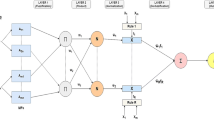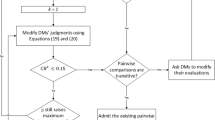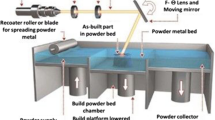Abstract
The present investigation deals with the proposal of a combined fuzzy-genetic algorithm (F-GA) model able to describe the inherent uncertainties related to the manufacture of open-cell aluminum foams by using the dissolution and sintering process (DSP). The use of the F-GA method allows to take into account, within the same model, both the uncertainty related to the model and the statistical manufacturing process variability. The developed model is aimed at controlling the capability of this material at absorbing energy in compressive deformation, for a different set of process parameters. In particular, the use of genetic algorithms allows the optimization of the support of the fuzzy numbers defined in the model in order to take into account most of the experimental data in combination with the smallest uncertainty. Then, the input uncertainty, related to both the process variability and the chosen model, is propagated to the output variables by the Transformation Method. The fuzzy results are then compared with the measured data and the membership level of the dataset to the uncertain model is evaluated. The process maps generated allow to select the operational parameters in order to obtain a desired process output, in combination with the lowest uncertainty level, providing, as additional information, how much the uncertainty of the model and the process varies by changing those operational parameters.
Similar content being viewed by others
References
Guarino S, Barbieri M, Pasqualino P, Bella G (2017) Fabrication and characterization of an innovative heat exchanger with open cell aluminum foams. Energy Procedia 118:227–232. https://doi.org/10.1016/j.egypro.2017.07.015
Banhart J (2000) Manufacturing routes for metallic foams. JOM 52:22–27. https://doi.org/10.1007/s11837-000-0062-8
Ashby MF, Evans AG, Fleck NA, Gibson LJ, Hutchinson JW, Wadley HNG (2000) Metal foams: a design guide
Liu J, He S, Zhao H, Li G, Wang M (2018) Experimental investigation on the dynamic behaviour of metal foam: from yield to densification. Int J Impact Eng 114:69–77. https://doi.org/10.1016/j.ijimpeng.2017.12.016
Koohbor B, Kidane A (2016) Design optimization of continuously and discretely graded foam materials for efficient energy absorption. Mater Des 102:151–161. https://doi.org/10.1016/j.matdes.2016.04.031
Xie B, Fan YZ, Mu TZ, Deng B (2017) Fabrication and energy absorption properties of titanium foam with CaCl 2 as a space holder. Mater Sci Eng A 708:419–423. https://doi.org/10.1016/j.msea.2017.09.123
Barbieri M, Di Ilio G, Patanè F, Bella G (2017) Experimental investigation on buoyancy-induced convection in aluminum metal foams. Int J Refrig 76:385–393. https://doi.org/10.1016/j.ijrefrig.2016.12.019
Chiappini D (2018) Numerical simulation of natural convection in open-cells metal foams. Int J Heat Mass Transf 117:527–537. https://doi.org/10.1016/j.ijheatmasstransfer.2017.10.022
Bai W, Yuan X, Liu X (2017) Numerical investigation on the performances of automotive thermoelectric generator employing metal foam. Appl Therm Eng 124:178–184. https://doi.org/10.1016/j.applthermaleng.2017.05.146
Nawaz K, Bock J, Jacobi AM (2017) Thermal-hydraulic performance of metal foam heat exchangers under dry operating conditions. Appl Therm Eng 119:222–232. https://doi.org/10.1016/j.applthermaleng.2017.03.056
Orihuela MP, Shikh Anuar F, Ashtiani Abdi I, Odabaee M, Hooman K (2018) Thermohydraulics of a metal foam-filled annulus. Int J Heat Mass Transf 117:95–106. https://doi.org/10.1016/j.ijheatmasstransfer.2017.10.009
Guarino S, Di Ilio G, Venettacci S (2017) Influence of thermal contact resistance of aluminum foams in forced convection: experimental analysis. Materials (Basel) 10:907. https://doi.org/10.3390/ma10080907
Kremer K (2004) Metal foams for improved crash energy absorption in passenger equipment. http://onlinepubs.trb.org/onlinepubs/archive/studies/idea/finalreports/highspeedrail/hsr-34final_report.pdf (accessed February 5, 2018).
Barletta M, Gisario A, Guarino S, Rubino G (2009) Production of open cell aluminum foams by using the dissolution and sintering process (DSP). J Manuf Sci Eng 131:041009. https://doi.org/10.1115/1.3159044
Costanza G, Dodbiba G, Tata ME (2016) Optimization of the process parameters for the manufacturing of open-cells iron foams with high energy absorption. Procedia Struct Integr 2:2277–2282. https://doi.org/10.1016/j.prostr.2016.06.285
Lázaro J, Solórzano E, Rodríguez-Pérez MA (2014) Alternative carbonates to produce aluminium foams via melt route. Procedia Mater Sci 4:275–280. https://doi.org/10.1016/j.mspro.2014.07.557
Lázaro J, Solórzano E, Rodríguez-Pérez MA, Rämer O, García-Moreno F, Banhart J (2014) Heat treatment of Aluminium foam precursors: effects on foam expansion and final cellular structure. Procedia Mater Sci 4:287–292. https://doi.org/10.1016/j.mspro.2014.07.559.
A. Byakova, Y. Bezim’yanny, S. Gnyloskurenko, T. Nakamura, Fabrication method for closed-cell aluminium foam with improved sound absorption ability, Procedia Mater Sci 4 (2014) 9–14. doi:https://doi.org/10.1016/j.mspro.2014.07.573.
Bai M, Chung JN (2011) Analytical and numerical prediction of heat transfer and pressure drop in open-cell metal foams. Int J Therm Sci 50:869–880. https://doi.org/10.1016/j.ijthermalsci.2011.01.007
Woudberg S, Du Plessis JP (2016) An analytical Ergun-type equation for porous foams. Chem Eng Sci 148:44–54. https://doi.org/10.1016/j.ces.2016.03.013
Stark JR, Prasad R, Bergman TL (2017) Experimentally validated analytical expressions for the thermal efficiencies and thermal resistances of porous metal foam-fins. Int J Heat Mass Transf 111:1286–1295. https://doi.org/10.1016/j.ijheatmasstransfer.2017.03.041
Wang Y, Zhai X, Wang W (2017) Numerical studies of aluminum foam filled energy absorption connectors under quasi-static compression loading. Thin-Walled Struct 116:225–233. https://doi.org/10.1016/j.tws.2017.03.032
Rajak DK, Kumaraswamidhas LA, Das S (2017) On the influence of porosity and pore size on AlSi17 alloy foam using artificial neural network. Ciência Tecnol Dos Mater 29:14–21. https://doi.org/10.1016/j.ctmat.2017.05.004
Raj RE, Daniel BSS (2008) Prediction of compressive properties of closed-cell aluminum foam using artificial neural network. Comput Mater Sci 43:767–773. https://doi.org/10.1016/j.commatsci.2008.01.041
Jamshidi-Alashti R, Mohammadi Zahrani M, Niroumand B (2013) Use of artificial neural networks to predict the properties of replicated open-cell aluminum alloy foam via processing parameters of melt squeezing procedure. Mater Des 51:1035–1044. https://doi.org/10.1016/j.matdes.2013.05.026
Karen I, Yazici M, Shukla A (2016) Designing foam filled sandwich panels for blast mitigation using a hybrid evolutionary optimization algorithm. Compos Struct 158:72–82. https://doi.org/10.1016/j.compstruct.2016.07.081
Rodger JA (2014) Application of a Fuzzy Feasibility Bayesian Probabilistic Estimation of supply chain backorder aging, unfilled backorders, and customer wait time using stochastic simulation with Markov blankets. Expert Syst Appl 41:7005–7022. https://doi.org/10.1016/j.eswa.2014.05.012
Pandey AK, Dubey AK (2013) Fuzzy expert system for prediction of kerf qualities in pulsed laser cutting of titanium alloy sheet. Mach Sci Technol 17:545–574. https://doi.org/10.1080/10910344.2013.806182
Suarez Andrade HI, Hernández Rojas ME, Palomar Pardavé ME, Pimiento SB, Suarez, -Andrade HI, Hernández, - Rojas ME, Palomar - Pardavé ME, Báez, - Pimiento S (2013) Manufacturing of aluminum foams using the sintering dissolution process. Rev Colomb Mater N 5:292–298 http://aprendeenlinea.udea.edu.co/revistas/index.php/materiales/article/viewFile/19235/16521 (accessed January 9, 2018)
Ponticelli GS, Guarino S, Giannini O (2017) A fuzzy logic-based model in laser-assisted bending springback control. Int J Adv Manuf Technol 95(1–12):3887–3898. https://doi.org/10.1007/s00170-017-1482-8
Aravind S, Shunmugesh K, Biju J, Vijayan JK (2017) Optimization of micro-drilling parameters by Taguchi grey relational analysis. Mater Today Proc 4:4188–4195. https://doi.org/10.1016/j.matpr.2017.02.121
Cortés Sáenz D, Gordillo Castillo N, Riba Romeva C, Lloveras Macià J (2015) A fuzzy approach for the selection of non-traditional sheet metal cutting processes. Expert Syst Appl 42:6147–6154. https://doi.org/10.1016/j.eswa.2015.03.030
Susilawati A, Tan J, Bell D, Sarwar M (2015) Fuzzy logic based method to measure degree of lean activity in manufacturing industry. J Manuf Syst 34:1–11. https://doi.org/10.1016/j.jmsy.2014.09.007
Taheri SM (2003) Trends in fuzzy statistics. AUSTRIAN J Stat 32:239–257 http://www.statistik.tuwien.ac.at/oezstat/ausg033/papers/taheri.pdf (accessed July 4, 2017)
Haag T, Herrmann J, Hanss M (2010) Identification procedure for epistemic uncertainties using inverse fuzzy arithmetic. Mech Syst Signal Process 24:2021–2034. https://doi.org/10.1016/j.ymssp.2010.05.010
Hanss M (2002) The transformation method for the simulation and analysis of systems with uncertain parameters. Fuzzy Sets Syst 130:277–289 www.elsevier.com/locate/fss (accessed July 5, 2017)
Moore MJ, R E, Kearfott R B (1966) Cloud, introduction to interval analysis
Dao SD, Abhary K, Marian R (2017) A bibliometric analysis of genetic algorithms throughout the history. Comput Ind Eng 110:395–403. https://doi.org/10.1016/j.cie.2017.06.009
Esen İ, Koç MA (2015) Optimization of a passive vibration absorber for a barrel using the genetic algorithm. Expert Syst Appl 42:894–905. https://doi.org/10.1016/j.eswa.2014.08.038
Goodall R, Marmottant A, Salvo L, Mortensen A (2007) Spherical pore replicated microcellular aluminium: processing and influence on properties. Mater Sci Eng A 465:124–135. https://doi.org/10.1016/j.msea.2007.02.002
Montgomery DC (2009) Introduction to statistical quality control, sixth edit. Wiley http://dl4a.org/uploads/pdf/581SPC.pdf (accessed October 2, 2018)
Author information
Authors and Affiliations
Corresponding author
Rights and permissions
About this article
Cite this article
Ponticelli, G.S., Guarino, S., Tagliaferri, V. et al. An optimized fuzzy-genetic algorithm for metal foam manufacturing process control. Int J Adv Manuf Technol 101, 603–614 (2019). https://doi.org/10.1007/s00170-018-2942-5
Received:
Accepted:
Published:
Issue Date:
DOI: https://doi.org/10.1007/s00170-018-2942-5




